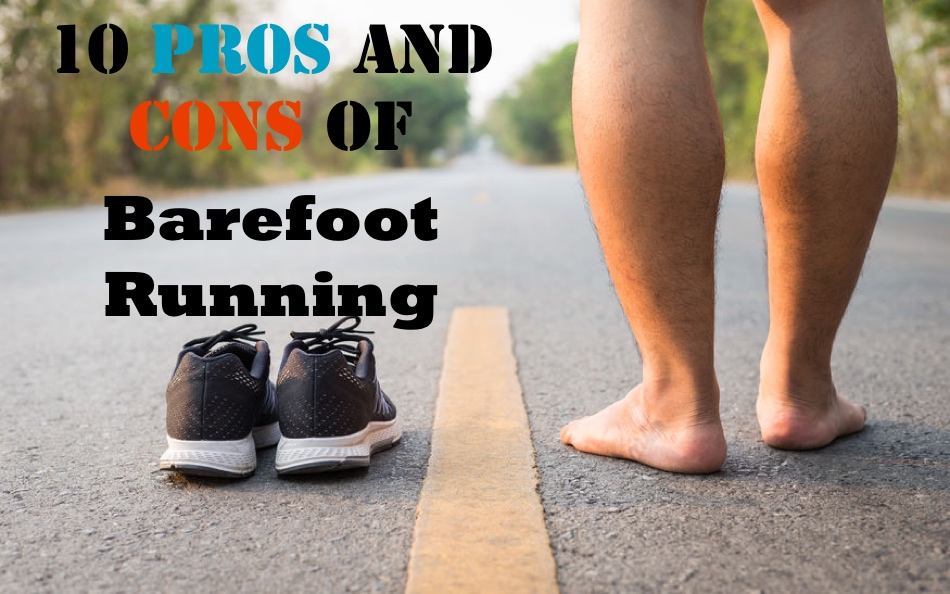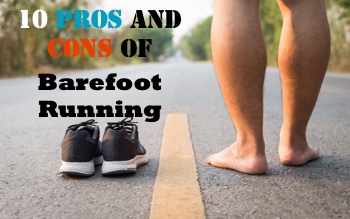
Some of the Good and the Bad of Barefoot Running
10 Pros and Cons of Barefoot Running
Table of Contents
On this website, we’ve talked a lot about the pros and cons of going Barefoot, but how does that apply specifically to Barefoot Running? I’ve done a lot of research on Barefoot Running and put together a list of 10 pros and cons of Barefoot Running.
The Pros of Barefoot Running
1.Barefoot Running Strengthens your Feet
I have written about this other article on Barefoot drills to strength feet. Running barefoot will allow you to use all of your innate foot muscles the way they were designed to be used. The Human foot has a large number of muscles and connective tissues that all fire when we walk and run barefoot.
Running in traditional shoes greatly restricts the full use of these muscles and causes them to relax and become weaker. Barefoot running activates all you tendons muscles and ligaments as you develop your signature natural gait and running pattern.
Barefoot running does indeed improve your foot strength.
2.Barefoot Running puts less Negative Forces on your Body
As you run Barefoot, you will inevitably be forced to change your running style. The heel striking running approach, where there is a reliance on the thick wedge of foam in the heels of most running shoes will no longer be a viable option.
Those huge heels on your running shoes that are purported to absorb and cushion the forces you load when heel striking become redundant.
When you run Barefoot. However, you are a lot lighter on your feet barely touching the ground as you move along on your run. You will be running on the mostly on the balls of your feet and toes as you move away from heel striking.
Forefoot striking as you run is much better for your body.
The overall effect is that there are no longer the jarring forces of heel striking impacting your ankles knees and hips as you run.
Hence your body will suffer less wear and tear from these additional forces acting on you on a barefoot run.
Barefoot running is much better for the long-term health of your body.
3.Barefoot Running Improves your Balance
The big word here is proprioception. In simple terms, it brings together all the elements of balance and coordination and sense of space and time. This sense is greatly diminished when we are in shoes.
Connecting to the ground from the feet up allows you to activate all the sensors at the soles of your feet and truly get a sense of connectivity to the earth.
Picking your path on your route and using all of your feet as you navigate the terrain on the run is a lot of fun.
Improved balance from running barefoot helps you enjoy your run even more.
4.Barefoot Running Improves your Stride Pattern
As a barefoot runner, your running pattern will be forefoot striking as I discussed above. Forefoot striking means you land on the balls of your feet as you run in short choppy motions.
Studies have shown that when you forefoot strike, there is significantly less contact of your foot with the ground. You also benefit from reduced stride length as you no longer need to overstride to make progress on your run.
Lastly, your stride frequency will increase as you run like this giving you a faster leg turnover and more efficiency.
Barefoot Running encoureges a more upright position, shorter strides, and a faster cadence are all pros of running barefoot.
5.Barefoot Running Improves your posture
When we bring together some just some or the point mentioned above one of the resultant benefits is a vast improvement of posture.
Have you ever seen someone in high heel shoes? Next time you do take another look and see the abnormal loading on ankles, knees and hips. This is why service-oriented people know not to wear heels if they are on their feet all day and wear flats. If they could go barefoot, I’m sure they would.
The fact that you are now forefoot striking means that you can now run in a more upright position, with your hips fully opened up and extended. This will improve their mobility and activation.
Your strengthened muscles, ligaments and tendons from the barefoot running will mean that you will have all the core strength you need to support your body in the correct posture.
The Cons of Barefoot Running
6.Barefoot Running gives you a lot less Foot Protection
In today’s modern street architecture there are many perceived and real hazards of walking and running barefoot. Let’s start with the tarmac covered roads and concrete pavement to tiled floors and other surfaces we navigate in shoes daily without a second thought.
When you are wearing shoes, you get insulation in cold weather and protection from frostbite in the winter from ice and snow.
Once you are barefoot, its a game changer. Most of us have very soft soles due to spending a lifetime in shoes. The soles of our feet are not conditioned to deal with minor hazards like small sharp stones and glass nails etc.
I would contend though that some of the hazards are more perceived than real. While the risks do exist going completely barefoot, you will have to deal with their sensitivity till the soles of your feet get used to it and become tougher.
For some, this is a non-starter and barefoot shoes are the option that makes the most sense.
7.The Transition to Barefoot Running can be painful
Moving into barefoot running or walking can be taxing on your leg muscles in the beginning. I go into it in a lot of details in my article How to Run Barefoot (The Beginners Guide) Running barefoot especially in the beginning will leave you sore after your begin forefoot striking.
As you run barefoot, you will begin to use muscles in your feet you didn’t even know existed. During my research, I found that
The foot and ankle contains: 26 bones, 33 joints; more than 100 muscles, tendons and ligaments
Forefoot striking will make you activate all these muscles, and you will get DOMS (delayed onset muscle soreness).In some instances, you can get injuries such as Achilles tendonitis or calf strain when the heel from traditional shoes is no longer there for your fee to rely on.
The pain from DOMs will only last a few days in most cases and will get a lot less the more you practice your running.
8.Barefoot Running is not for everyone
Sometimes there is no need to go barefoot at all. Even though there are many benefits of doing so, you may be doing just fine as you are. If this is you, there is no need to go through the step by step of transitioning to barefoot running.
9.Learning to run Barefoot takes time
Learning to run barefoot takes a lot of time and dedication. This can be difficult for a lot of people to accept. I have talked lots of people through the process and harped on the need to take it slow and go through process and drills.
The idea of running barefoot or wearing minimalist shoes does come with some transitioning time
Have a read of my post on exercises to strengthen your feet to see what I mean in more detail.
10.There are a lot fewer places to run Barefoot
As I mentioned in point 6, there will be a good number of restrictions on where you can truly run barefoot especially in urban areas.
You will need to seek out trails or predefined and planned routes where you can safely do so. This amount of effort can restrict your running experience. Bear this in mind especially if you are a runner already who is used to putting on your shoes and going for a run.
The option will be to wear barefoot/ minimalist shoes to overcome this. Have a look at my recommended gear page for some ideas and see what I use and why.
